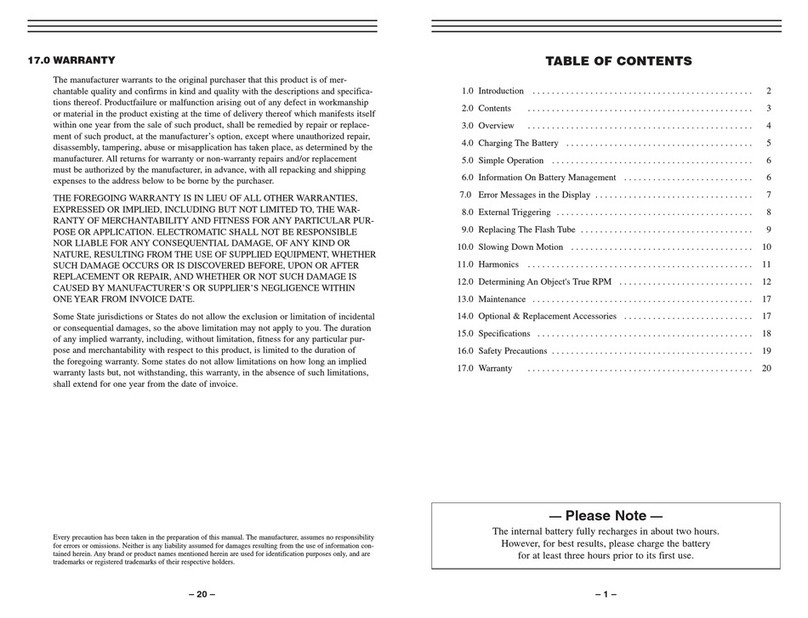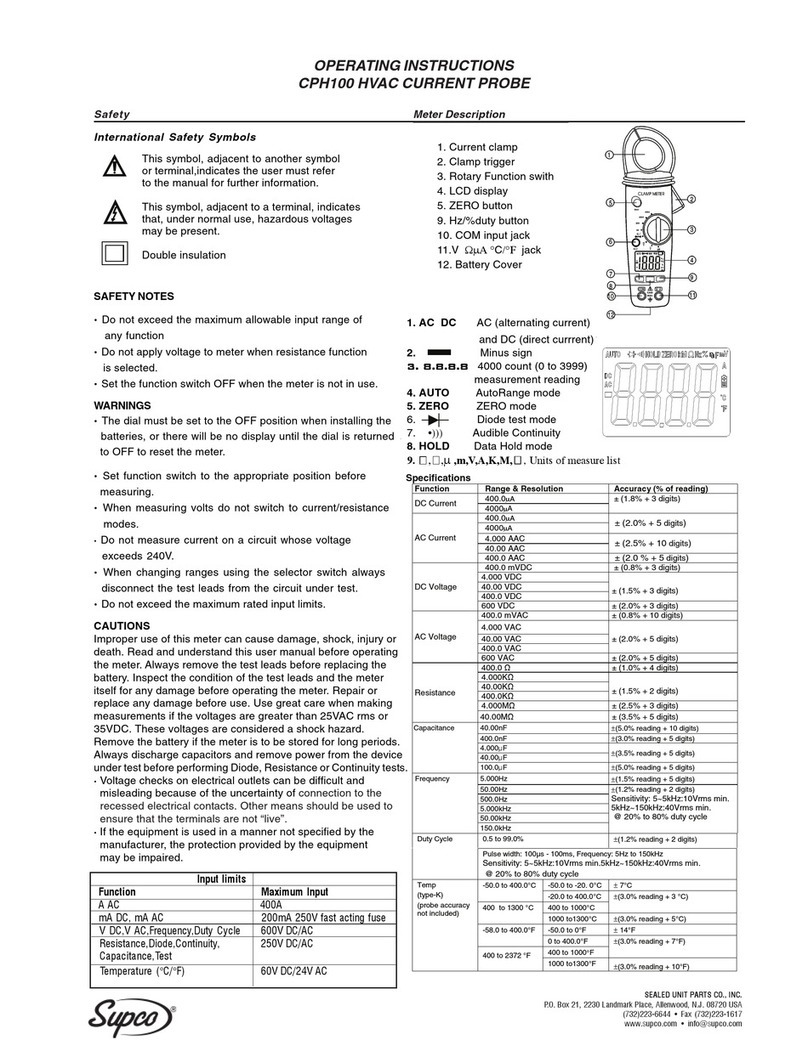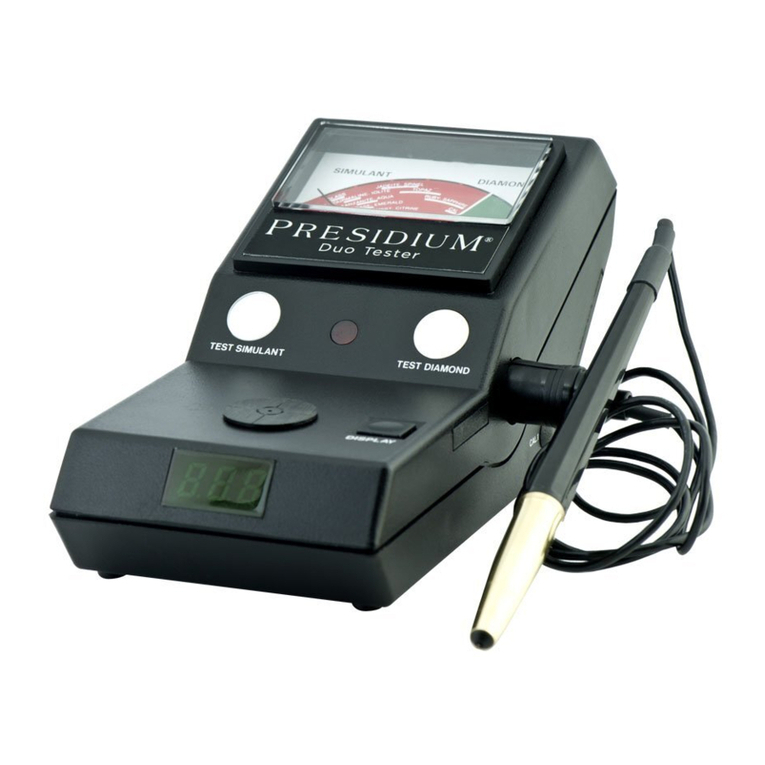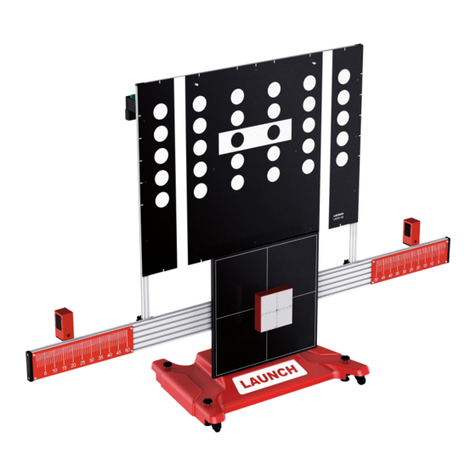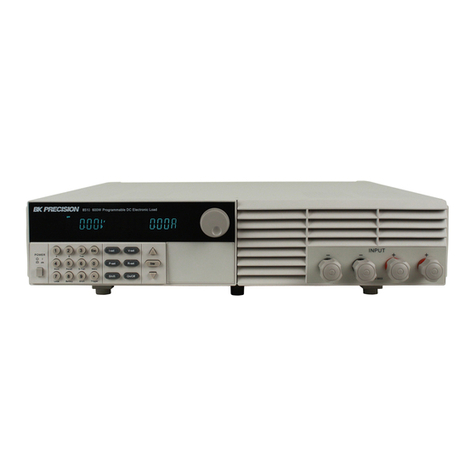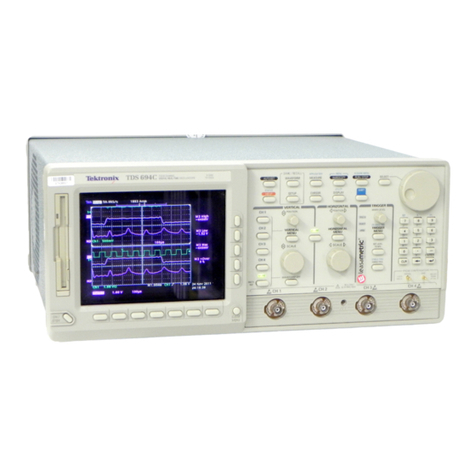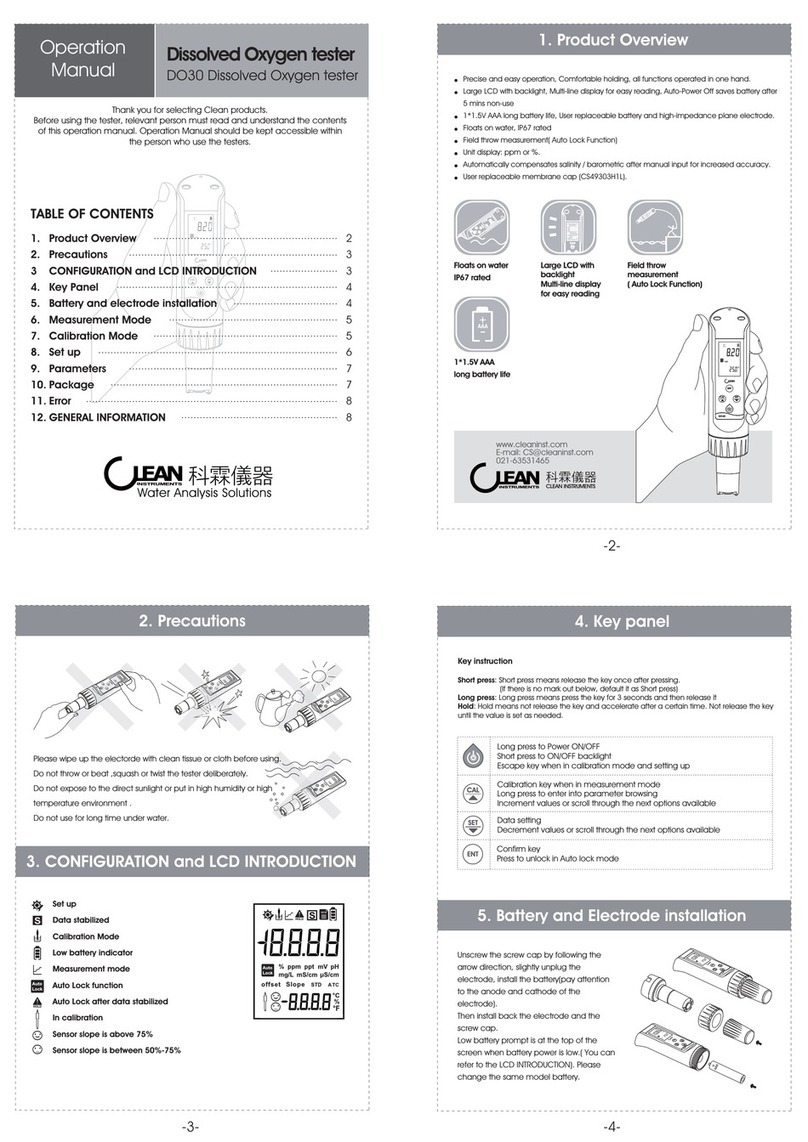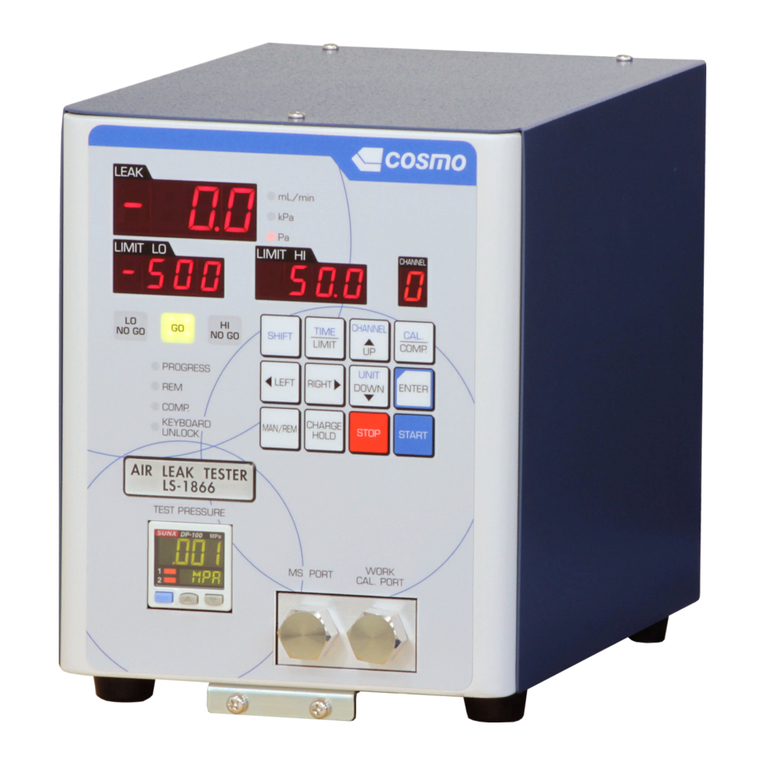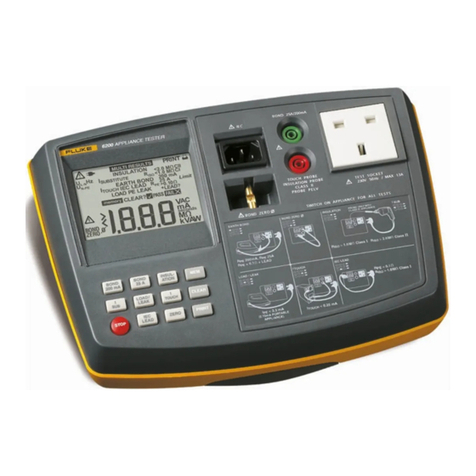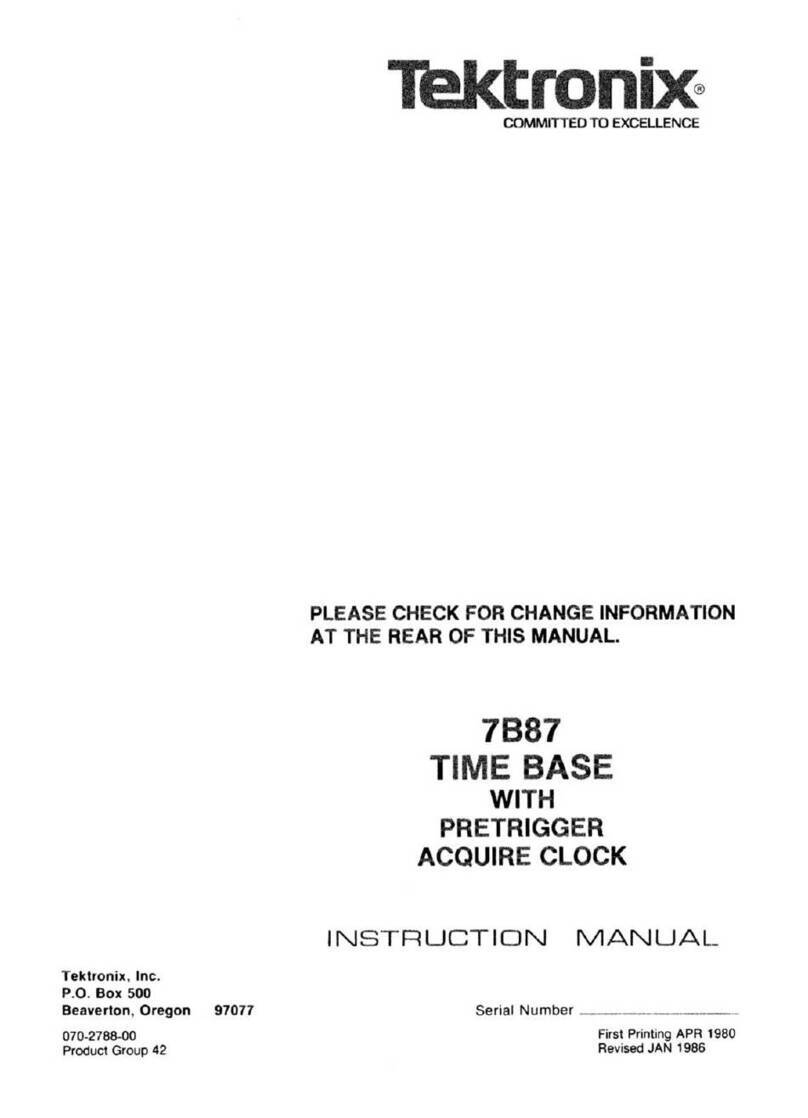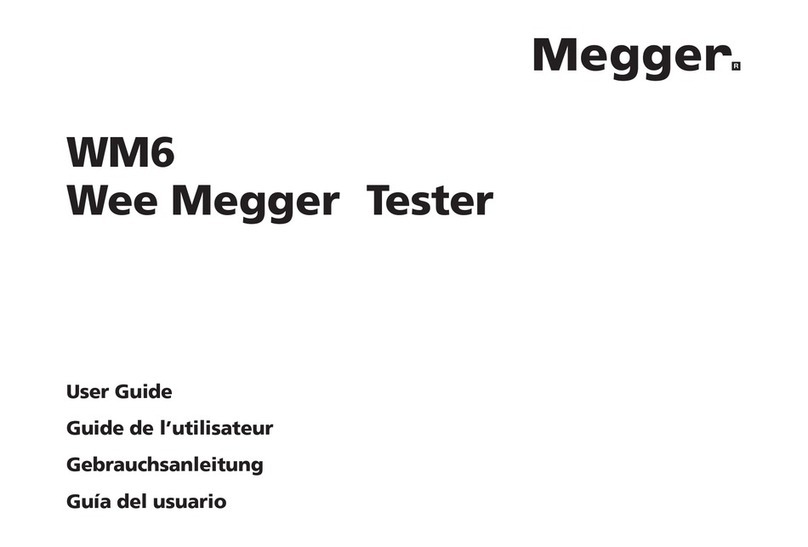Check-line DS-2000LED User manual

–1–
TABLE OF CONTENTS
01.0 Introduction . . . . . . . . . . . . . . . . . . . . . . . . . . . . . . . . . . . . . . 02
02.0 Contents . . . . . . . . . . . . . . . . . . . . . . . . . . . . . . . . . . . . . . . . 02
03.0 Overview . . . . . . . . . . . . . . . . . . . . . . . . . . . . . . . . . . . . . . . . 03
3.1 Display
3.2 Mode Keys
04.0 Installing/Changing the batteries . . . . . . . . . . . . . . . . . . . . . 05
05.0 Operation (LS-2000LED) . . . . . . . . . . . . . . . . . . . . . . . . . . . . 06
5.1 Special Functions
06.0 Additional Operating Instruction (OT Models Only) . . . . . . 08
07.0 Safety Precautions . . . . . . . . . . . . . . . . . . . . . . . . . . . . . . . . . 10
08.0 Slowing Down Motion . . . . . . . . . . . . . . . . . . . . . . . . . . . . . . . 11
09.0 Harmonics . . . . . . . . . . . . . . . . . . . . . . . . . . . . . . . . . . . . . . . . 12
10.0 Determining An Object’s True RPM . . . . . . . . . . . . . . . . . . . 13
11.0 Multi-Key Combination Features . . . . . . . . . . . . . . . . . . . . . 17
12.0 Specifications . . . . . . . . . . . . . . . . . . . . . . . . . . . . . . . . . . . . . . 18
13.0 Factory Default Parameter Settings . . . . . . . . . . . . . . . . . . . 19
14.0 Warranty . . . . . . . . . . . . . . . . . . . . . . . . . . . . . . . . . . . . . . . . 20
–20–
14.0 WARRANTY
The manufacturer warrants to the original purchaser that this product
is of merchantable quality and confirms in kind and quality with the
descriptions and specifications thereof. Productfailure or malfunction
arising out of any defect in workmanship or material in the product
existing at the time of delivery thereof which manifests itself within one
year from the sale of such product, shall be remedied by repair or
replacement of such product, at the manufacturer’s option, except where
unauthorized repair, disassembly, tampering, abuse or misapplication
has taken place, as determined by the manufacturer. All returns for
warranty or non-warranty repairs and/or replacement must be
authorized by the manufacturer, in advance, with all repacking and
shipping expenses to the address below to be borne by the purchaser.
THE FOREGOING WARRANTY IS IN LIEU OF ALL OTHER
WARRANTIES, EXPRESSED OR IMPLIED, INCLUDING BUT NOT
LIMITED TO, THE WARRANTY OF MERCHANTABILITY AND
FITNESS FOR ANY PARTICULAR PURPOSE OR APPLICATION.
ELECTROMATIC SHALL NOT BE RESPONSIBLE NOR LIABLE
FOR ANY CONSEQUENTIAL DAMAGE, OF ANY KIND OR NATURE,
RESULTING FROM THE USE OF SUPPLIED EQUIPMENT,
WHETHER SUCH DAMAGE OCCURS ORIS DISCOVERED BEFORE,
UPON OR AFTER REPLACEMENT OR REPAIR, AND WHETHER
OR NOT SUCH DAMAGE IS CAUSED BY MANUFACTURER’S OR
SUPPLIER’S NEGLIGENCE WITHIN ONE YEAR FROM INVOICE
DATE.
Some State jurisdictions or States do not allow the exclusion or
limitation of incidental or consequential damages, so the above
limitation may not apply to you. The duration of any implied warranty,
including, without limitation, fitness for any particular purpose and
merchantability with respect to this product, is limited to the duration
of the foregoing warranty. Some states do not allow limitations on how
long an implied warranty lasts but, not withstanding, this warranty, in
the absence of such limitations, shall extend for one year from the date
of invoice.
Every precaution has been taken in the preparation of this manual. The manufacturer,
assumes no responsibility for errors or omissions. Neither is any liability assumed for
damages resulting from the use of information contained herein. Any brand or product
names mentioned herein are used for identification purposes only, and are trademarks
or registered trademarks of their respective holders.
See page 10 for important safety precautions.

–2 –
1.0 INTRODUCTION
Congratulations on your purchase of a DS-2000LED or DS-2000LED-OT
portable stroboscope. The strobe is used to make objects which are
moving at high speeds to appear to move in slow motion or become
motionless. When this occurs, you can safely and easily analyze their
motion, check for proper registration, determine sources of unwanted
vibration, etc.
Typical applications include:
■High speed assembly lines, conveyor systems, bottling operations, etc.
■Printing presses and cloth looms
■Motors, fans, pumps and turbines
■Calibration and inspection equipment
■Monitoring laboratory & research applications
Models Available
■DS-2000LED: operates from Internal Rechargeable Battery or
AC-Power.
■DS-2000LED-OT: same as above but includes external trigger output.
2.0 CONTENTS
■Stroboscope
■ Operating manual
■Calibration certificate
■ Batteries
■Case
■OT Model Only: Cable with plug for trigger signal
2.1 Optional Accessories
■Tripod adapter
■ Tripod
■Calibration certificate
■Belt pouch
–19–
13.0 FACTORY DEFAULT PARAMETERS
The standard parameters on the LED Strobe are:
■ TRIGGER INT (Internal)
■FPM 1000
■Hz 16.6
■PULSE µm 333
■PULSE deg 2.0°
■DELAY ms 0.0
■ PHASE deg. 0°
■DIVIDER 1
■OPTION 0

–3–
3.0 OVERVIEW
1
2
43
5
6
7
8
9
10
11
14
12
13
3.1 Display
1PULS µs Flash duration (in microseconds)
2 PULS deg Flash duration (in degrees).
3DELAY ms Delay time (in milliseconds) between the
internal trigger signal and the flash.
–18–
12.0 SPECIFICATONS
GENERAL DATA
Protection class IP65
Frequency range 30 – 300.000 FPM
Display LCD, multiple lines
Accuracy 0,02% (+/- 1 digit)
Resolution ± 0,1 (30 ... 999 FPM)
Certified CE
FLASH PARAMETER
Flash duration Adjustable
Light emission 3000 Lux @ 6000 FPM / 20cm (7,9 inch)
Flash color ca. 6.500 K / Approx. 6.500 K
POWER SUPPLY
Power supply 3 x AA size disposable batteries or
3 x NiMH rechargeable batteries
Continuous use time NiMH: approx. 11 h @ 6.000 FPM
Disposable: approx. 6 h @ 6.000 FPM
HOUSING
Material Aluminium / ABS Heavy duty design
Dimensions 191 x 82 x 60 mm / 7,5 x 3,2 x 2,4 inch
Weight Approx. 400g (including batteries)
AMBIENT CONDITIONS
Temperature Range 0° ... 45° C / 32° ... 113° F
Humidity Protection code IP65
Additional information for Stroboscope Pocket LED with trigger input and output
TRIGGER INPUT
Principle Optocoupler, voltage-free
Low level < 1 V
Level 3 … 32 V, NPN + PNP
TRIGGER OUTPUT
Principle Short-circuit and overvoltage proof transistor
output to the optocoupler control, non-isolated
Level max. NPR, max32V
Pulse length Adjustable
Maximum current 50mA
Reverse voltage protection Yes

– 4 –
04PHASE deg Delay time between the internal trigger signal
and the flash (in degrees relative to the
frequency).
05DIV Pulse divider, maximum value 255
06OPT Trigger signal edge selection
0 = positive edge
1= negative edge
07Display For units, see numbers 8-10.
08FPM Flashes per minute.
091/min Rotations per minute
10 Hz Frequency of motion per second.
11 RANGE External trigger signal is causing the flash
frequency to be too high
12 EXT External trigger signal selected
13 INT Device is generating flash frequency.
14 LOBAT Battery running low
NOTE: A parameter which has been set to differ frm the default setting
flashes during operation.
3.2 Mode Keys
On/Off Press and hold down the button for approx.
3 seconds
Mode Button Each time the Mode Button is pressed, the
gauge switches to the next setting in the
numerical order (1–10, see pages 3 & 4).
NOTE: Some modes only effect the functioning of the device when
external triggering is employed.
Increases the currently set value.
Speeds up when this button is held down.
Halves the currently set value.
Speeds up when this button is held down.
Doubles the currently set value.
Speeds up when this button is held down.
Lowers the currently set value.
Speeds up when this button is held down
–17–
Helpful Hints
■The most commonly used formulas are indicated by an asterisk.
■The values for “X,” “Y” and “Z” are taken in descending order. For
example, the value for “X” is greater than the value for “Y.”
■The values are for successive singular harmonic images. Do not use
multiple images.
■If two points are recorded, equation (1) Y gives only approximate
results. Equations (2) with (4) and (3) with (5) are more precise, but
error can be introduced due to the rounding.
■If three points are found, Equation (6) is the most commonly-used
formula.
■For completeness, equations (9) through (21) offer mathematical
derivations and condensed versions of Equation (6). Also included
are the formulas for calculating Sx, Sy and Sz.
11.0 MULTI-KEY COMBINATION FEATURES
M
+
*
–
\Key Description of Functions
M
+Pressing both buttons simultaneously resets
the gauge to its default settings.
–
+Pressing both buttons simultaneously
activates and deactivates the Button Lock.
M
+Pressing both buttons simultaneously
switches between internal and external
trigger signals.

–5–
4.0 INSTALLING/CHANGING THE BATTERIES
1. If strobe is ON, switch the power OFF by pressing and holding the
button (see pages 3 and 4) for 3 seconds.
2. Unscrew the 2 screws at back of the strobe and remove the battery
compartment cover.
3. Insert 3 new, fully charged AAA batteries into the battery
compartment, following the polarity marked on the case.
4. Replace the battery cover and screws.
Do not overtighten.
NOTE: Disposable or rechargeable (NiMH) batteries may be used.
–16–
Step 2: As the flash rate is lowered, three singular harmonic images
are found.(The first image at 9,600 RPM is rejected because it
is a double image). Point "X" is 7,200, point "Y" is 4,800 and
Point "Z" is 3,600.
Step 3: To calculate the true RPM, enter these values into one of
the equations shown below. For this example, we will use
equation (6).
RPM = 2AB(A+B)/(A-B)2
= 2x2,400x1,200x(2,400+1,200)/
(2,400-1,200)2
=14,400
Where A = (X-Y)
= 7,200 - 4,800
= 2,400
And B = (Y-Z)
= 4,800 – 3,600
= 1,200
Therefore, the true speed of the object is 14,400 RPM. To help further
illustrate this point, the figure below shows the harmonic relationship of
the four images found in this example:
If TWO points, “X” and “Y” are
recorded:
(1) *RPM = XY/(X-Y)
(2) *RPM =Sx(Sx+1)(X-Y)
(3) RPM =S (S -1)(X-Y)
(4) *Sx= Y/(X-Y), rounded
(5) Sy= X/(X-Y), rounded
If THREE points, “X,” “Y” and “Z”
are recorded:
(6) *RPM = 2AB(A+B)/(A-B)2
(7) *A= (X-Y)
(8) *B (Y-Z)
Variations of THREE point formulas:
(9) *RPM = 2PS/D2
(10) P = Product, (A*B)
(11) S = Sum, (A+B)
(12) D = Difference, (A-B)
(13) *Sx= 2(Y-Z)/(X+Z-2Y)
(14) Sy = (X-Z)/(X+Z-2Y)
(15) Sz= 2(X-Y)/(X+Z-2Y)
(16) *Sx= 2B/(A-B)
(17) Sy= (A+B)/(A-B)
(18) Sz= 2A/(A-B)
(19) Sx= 2B/D
(20) Sy= S/D
(21) Sz= 2A/D
Depending on the accuracy desired, either two or three harmonic points
can be found. These points are used in one of the following equations:
Formulas for calculating “Out of Range” RPMs.
Harmonic
FPM/RPM
1/4 1/3 1/2 2/3 5/6 1/1
3,600 4,800 7,200 9,600 12,000 14,400

– 6 –
5.0 OPERATION
1. Make sure that the strobe has 3 charged batteries in the battery
compartment; and they they are aligned in the corrected polarity.
2. Aim the strobe at a moving object, then press and hold the ON/OFF
Button for approximately 3 seconds.There will be a slight delay
before the strobe begins flashing. The strobe will flash at the most
recently set frequency in flashes per minute, which appears on the
display.
NOTE: If the Low Battery icon begins to flash (item 15, page 4),
replace the batteries (see section 4).
3. Press the Mode Button to cycle through the different settings.
Stop when the desired setting is highlighted on the display..
Display fields Influencing the set signal. Refer to figure on page 3.
01 PULS µs Flash duration (in microseconds).
02 PULS deg Flash duration (in degrees).
03DELAY ms Delay time (in milliseconds) between the internal
trigger signal and the fl ash.
04PHASE deg Delay time between the internal trigger signal
and the flash (in degrees,relative to the
frequency).
Units deisplayed. Refer to figure on page 3.
08 FPM Flashes per minute.
10 Hz Frequency of motion per second.
Operating information
13 INT Device is generating flash frequency.
14 LOBAT Battery is running low.
NOTE: A parameter which has been set to differ from the default setting
flashes during operation.
NOTE: Pressing the and buttons simultaneously resets the
strobe to its default settings.
NOTE: Some modes only effect device functioning when external
triggering is employed.
NOTE: Static images are not only created at a precisely corresponding
flash frequency, but also at multiples and fractions of this
frequency.
–15–
The harmonic images at 6,000 and 4,000 RPM are not singular, but dou-
ble and quadruple. A singular image does appear at 3,000 and again at
1,500 RPM. 1,500 is one half of 3,000. Therefore, the rate is 3,000 RPM.
Example 3: (Out of Range)
This final example shows how speeds faster than 12,000 RPM (the upper
limit of the Pocket-Strobe) can be calculated.
This is the object which is rotating. Its speed is known
only to be greater than 12,000 RPM. Because it has a
uniform shape, an orientation mark is added.
To determine its speed, three steps are required:
1. Starting from the maximum speed of the strobe, slowly reduce the
flash rate. Look for singular frozen harmonic images.
2. Find at least two images. (For greater accuracy, find three). Label
these rates as“X,” “Y’ (and possibly “Z”).
3. Plug these values into a suitable equation (see page 19) and calculate
the object’s RPM.
Step 1: As the speed is reduced, the following images appear:
Image No.: 1 2 3 4
Flash Rate: 6,000 4,000 3,000 1,500
Image No: 1 2 3 4
Flash Rate: 9,600 7,200 4,800 3,600
Point “X” Point “Y” Point “Z”
M
M

–7–
4. If the flash frequency corresponds to the motion frequency, a static
image will be created. If the image does not appear static (motion-
less), adjust the flash frequency using the Adjustment Buttons as
indicated below
Increases the currently set value.
Speeds up when this button is held down.
Halves the currently set value.
Speeds up when this button is held down.
Doubles the currently set value.
Speeds up when this button is held down.
Lowers the currently set value.
Speeds up when this button is held down.
CAUTION: Although the object may appear to be motionless, it is
still moving and should NEVER be touched.
5 The following functions are activated by simultaneously pressing
the buttons shown below:
+ = Reset to default settings
+ = Activate/Deactivate Button Lock.
Prevents current settings from being changed accidentally
5.1 Using Special Functions
PULS µs/PULS deg:
Flash duration. This function enables you to set the fl ash duration.
Using this function, you can influence the brightness and focus of
the object of observation. This adjustment can either bemade in
absolute form (microseconds) or in relative form (degrees).
DELAY ms
Adjustment of delay time between the internal trigger signal and
the flash (in milliseconds). Thisfunction enables you to set a fixed
delay time between the internal trigger signal and the flash.
Example: The position of observation can be adjusted extremely
precisely without altering the flash frequency. You can shift the
observation position within a motion cycle.
PHASE deg
Phase shift adjustment between the internal trigger signal and the
flash (in degrees, relative to the frequency). This function enables
you to set a fixed angle between the internal trigger signal and the
flash.
Example: The position of observation can be adjusted extremely
precisely without altering the flash frequency. You can shift the
observation position within a motion cycle.
CAUTION
!
–14–
What is the actual rate of the fan? Images 1, 3, 5, 7, and 8 are all
“frozen,” so the rate could be taken as 3,300. 1,100, 825, 660 or 550.
Which is correct?
In order to determine the fan’s actual speed, a mark is
added to one of the blades and the test is run again.
Image No.: 1 2 3 4
Flash Rate: 3.300 1,650 1,100 916.6
Image No.: 5 6 7 8
Flash Rate: 825 733.3 660 550
Using the orientation mark, it is now clear that the images appearing at
3,300, 825 and 660 RPM are multiple-image harmonics. In each of these
cases, three identification marks appear. On the other hand, a singular
image appears at 1,100 and again at 550.
Here, only one mark appears. Recall that “a singular image always
appears at exactly one half of the object’s true RPM.” 550 is one half
of 1,100. Therefore, the rate of the fan must be 1,100 RPM.
Example 2: (Within Range No Mark Needed)
This example illustrates how the actual speed of an object can be deter-
mined without the use of an orientation mark—provided that the object
has a suitable shape.
Assume that the speed of this cam is known only to be
less than 7,000 RPM. Because it has a unique shape, it
does not need an identifying mark. As the flash rate is
lowered from 7,000, the following harmonic images
appear.
M
+
*
–
–
–

– 8 –
6.0 ADDITIONAL OPERATING INSTRUCTIONS (OT MODEL ONLY)
1. Press the and buttons simultaneously to switch between
internal and external trigger signal.
CAUTION: Do not use signals over 300,000 FPM Hz to trigger the device.
Display fields (see pages 3 and 4)
Influencing the input signal before the flash is generated
3 DELAY ms Adjustment of delay time (in milliseconds) between
the internal trigger signaland the fl ash.
4 PHASE deg Phase shift adjustment between the internal trigger
signal and the flash (in degrees, relative to the
frequency).
5DIV Pulse divider, maximum value 255.
6OPT Trigger signal edge selection
0 = positive edge
1 = negative edge
T
rigger input
3 … 32V
BROWN
BLUE
Trigger output
max. 50mA
WHITE
BLACK
CAUTION
!
The trigger input is potential-free and is suitable for PNP
and NPN signals. A cable with plug, correspnding to
these iput jacks, is provided with the device.
Trigger Connection Assignment - Trigger Jack
–13–
10.0 DETERMINING AN OBJECT’S TRUE RPM
The strobe can be used as a digital tachometer to determine the true
RPM and/or the reciprocation rate of an object. This is done by visually
“freezing” the object’s movement and then reading the LCD display. As
with all stroboscopes, it is important to verify that this frozen image is
not a harmonic of the object’s actual rate.
Helpful Hints
■Knowing the approximate rate of the object in advance gives you a
useful starting point.
■If the object has a uniform shape, like a multi-blade fan or motor
shaft, you must give it an identifying mark (using paint or reflective
tape or equivalent) in order to differentiate its orientation.
■A singular image always appears at exactly one half of the object’s
true RPM.
■Mathematical harmonic techniques can be used to determine an
object’s true RPM if it is greater than the upper limit of the
stroboscope.See Example 3 on page 15.
Example 1 (Within Range):
This example shows why identifying marks are
important.
Suppose you want to determine the true RPM of this
fan. The only thing you know is that its speed is less
than 3,500 RPM. If you slowly decrease the flash rate
starting from 3,500 FPM, the following “frozen” images
appear:
Image No.: 1 2 3 4
Flash Rate: 3.300 1,650 1,100 916.6
Image No.: 5 6 7 8
Flash Rate: 825 733.3 660 550
M

–9–
Unit displayed
91/min Rotations per minute.
10 Hz Frequency of motion per second.
NOTE: When an external trigger signal is used, the units 1/min (rather
than FPM) or Hz are displayed.
Operating information
11 RANGE External trigger signal is causing the flash frequency to
be too high.
12 EXT External trigger signal selected.
13 INT Device is generating flash frequency.
NOTE: A parameter which has been set to differ from the default
setting flashes during operation.
6.1 Using Special Functions (OT model)
DELAY ms
Adjustment of delay time between the internal trigger signal and
the flash (in milliseconds). This function enables you to set a fixed
delay time between the input signal and the output signal.
Example: The external trigger signal is generated before the
required observation point (= flash position of the stroboscope). In
this case the connected stroboscope would regularly fl ash too soon.
With the DELAY ms function, you can set the value by which the
output signal should be delayed.
PHASE deg
Phase shift adjustment between the internal trigger signal and the
flash (in degrees, relative to the frequency). This function enables
you to set a fixed angle between the internal trigger signal and the
flash.
Example: The external trigger signal is generated before the
required observation point (=f lash position of the stroboscope). In
this case the connected stroboscope would regularly fl ash too soon.
With the PHASE deg function, you can adjust the delay so that the
fl ash position of the stroboscope is altered by a set angle. This
setting is independent of the current speed ofrotation, which means
that the stroboscope will flash at the required position even during
the start-up process or when the speed of rotation is fluctuating.
–12–
9.0 HARMONICS
If you continuously increase the flash rate while strobing an object, it
may appear to freeze, slow down, speed up, go forward, freeze again, go
backwards, form multiple images, etc. These images appear at mathe-
matically determined multiples or harmonics of the object’s actual speed.
Example: Assume you wish to slow the motion of the fan used in the
last example, but you want it to be brighter.
Technique: Starting from 1,000 FPM, slowly increase the flash rate.
At 1,500 FPM the image will appear to freeze again.
Continue to increase the rate. The image will appear to
freeze again at 3,000 FPM. At this rate, the fan appears to be
very bright.
Helpful Hint:
■Harmonic images appear at both whole number multiples as well as
fractional intervals of the object’s actual rate. For example, a fan
rotating at 1,000 RPM will appear to be frozen at the whole number
multiples of 2,000 (2x), 3,000 (3x), 4,000 (4x) etc., as well as at the
fractional rates of 500 (1/2x),750 (3/4x), 833 (5/6x) and 1,500 (1 1/2x),
etc.
■Some of the harmonic images are “singular” in appearance while
others are “multiple.” This becomes important if you want to
determine the objects actual rate as discussed in section 10.0.

–10–
DIV (pulse divider)
This function is only active when an external trigger signal is
employed. With the pulse divideryou can set a value x, by which the
external trigger signal is then divided.
Example: An external trigger (e.g. rotation sensor) scanning a gear
wheel issues a signal forevery tooth scanned. At a DIV value of 10,
only every tenth input pulse is transmitted to the connected
stroboscope as a trigger signal.
OPT
Trigger signal edge selection. 0 = positive edge, 1 = negative edge.
With this option, the polarityof the trigger signal can be defined.
7.0 SAFETY PRECAUTIONS
Stroboscopes give the illusion of stopped motion.
Do not touch the machine or object being observed.
The use of stroboscopes may induce an epileptic seizure
in those persons predisposed to this type of attack.
Do not use this product in an explosive environment.
Do not use this product in wet or condensating
environments.
Do not allow liquids or metallic objects to enter into the
ventilation holes.
Wear adequate eye protection when using this product.
Failure to do so could result in serious injury.
The DS-2000LED / DS-2000LED-OT are designed for
battery operation only.Do not operate the instrument
while it is recharging. Failure to follow these
instructions willdamage the unit and void its warranty.
DANGER HIGH VOLTAGE!
To reduce risk of an electronic shock, do not open the
stroboscope. There are no user-serviceable parts inside.
–11–
8.0 SLOWING DOWN MOTION
As discussed, the primary use of the strobe is to slow down or “freeze”
the apparent motion of moving objects. This allows you to analyze their
run-time performances safely and easily.
To make an object appear to move in slow motion, you need to strobe it
at a rate slightly above or slightly below its actual speed or any
harmonic of its speed as discussed below.
Helpful Hints:
The speed at which the object appears to move can be determined by
subtracting the flash rate from the object’s actual rate.
Example: If an object is rotating at 1,000 RPM and you strobe it at a
rate of 1,005 flashes per minute (FPM), the object will appear
to be moving at a rate of 5 RPM.
Speed = Actual Rate minus Flash Rate
= 1,000 –1,005 = 5
= 5 RPM
The direction (clockwise vs. counterclockwise or forward vs. backward)
at which the object appears to move is determined by the flash rate,
the object’s actual direction of movement and the orientation of the
stroboscopic beam to the object.
Example: Assume you wish to visibly slow down the movement of a fan
which is rotating clockwise at 1,000 RPM.
Case 1: If you stand in front of it and strobe it at a rate of 1,005
flashes per minute (FPM), the object will appear to be moving
at a rateof 5 RPM in a counterclockwise direction.
Case 2: If you stand in front of it and strobe it at a rate of 995 FPM,
it will appear to move at a rate of 5 RPM in a clockwise
direction.
Case 3: If you stand behind it and strobe it at a rate of 1,005 FPM,
it will appear to move in a clockwise direction at a rate of 5
RPM.
Case 4: If you stand behind it and strobe it at a rate of 995 FPM, it
will appear to move in a counterclockwise direction at a rate
of 5 RPM
NOTE: Typically, stroboscopes are brightest (and can illuminate an
object the best) when the flash rate is between 2,000 and 6,000
FPM. Often, you can still make an object appear to be frozen or
moving in slow motion within this range because of the effect
of harmonics. This principle is explained section 9.0.
CAUTION
!

Pocket
STROBOSCOPE
CHECK
•LINE®
BY ELECTROMATIC
Models DS-2000LED / DS-2000LED-OT
OPERATING MANUAL
Distributed by: ABQ Industrial LP USA
Tel: +1 (281) 516-9292 / (888) 275-5772 eFax: +1 (866) 234-0451
Web: https://www.abqindustrial.net E-mail: [email protected]
This manual suits for next models
1
Table of contents
Other Check-line Test Equipment manuals
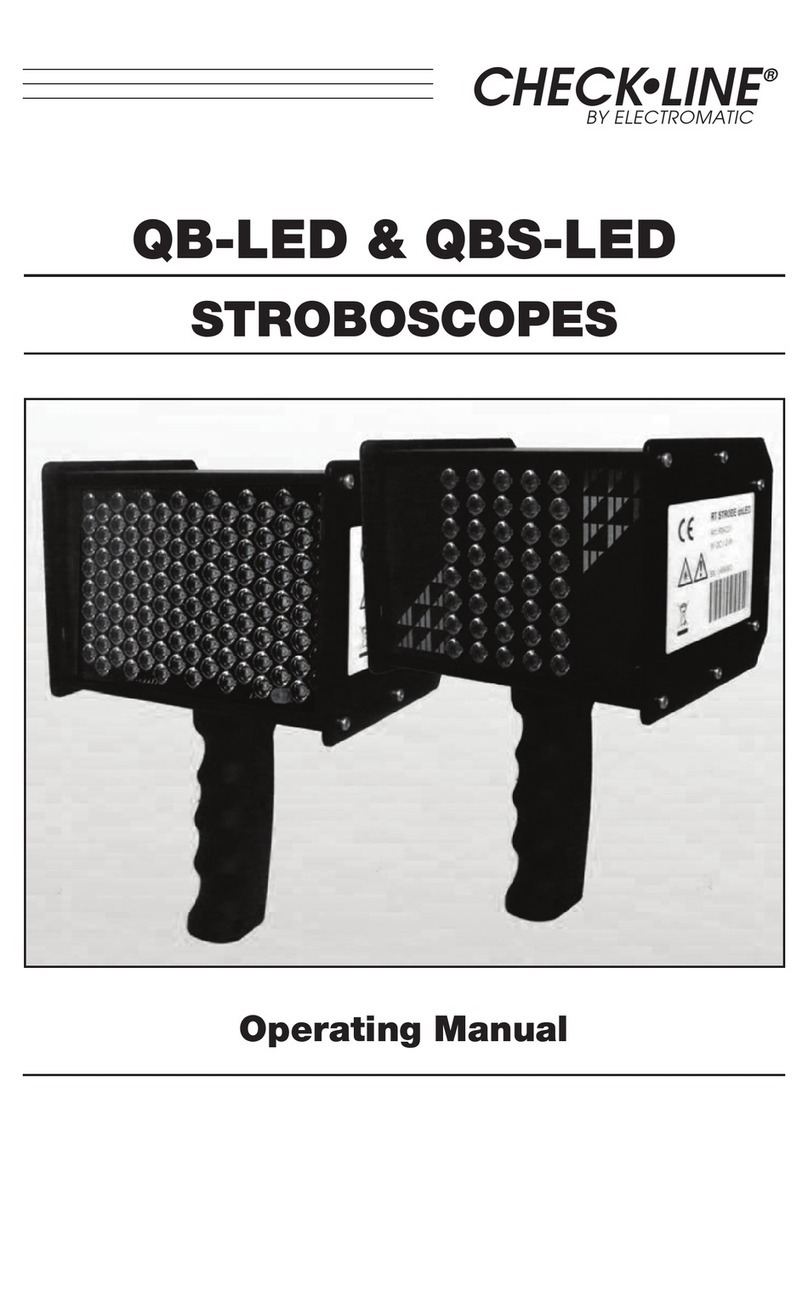
Check-line
Check-line QB-LED User manual
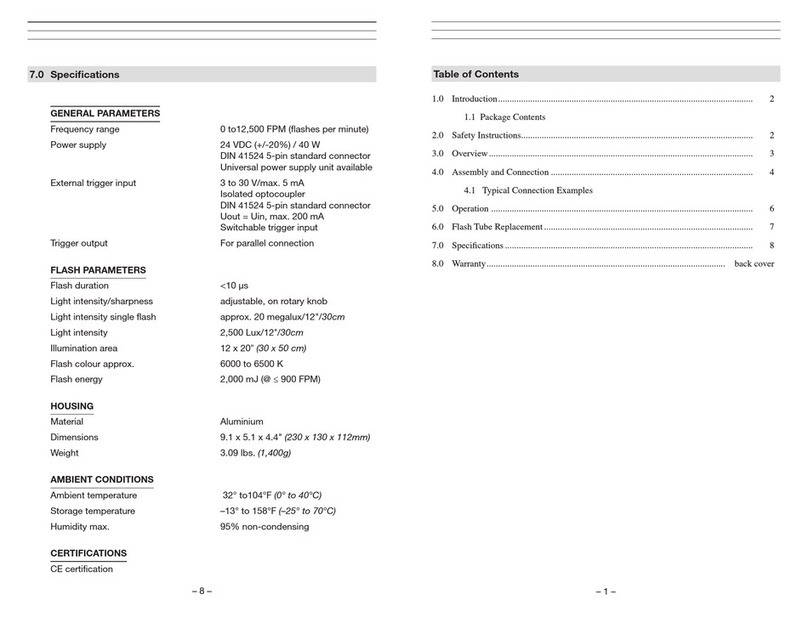
Check-line
Check-line LS-9-12000 User manual

Check-line
Check-line DT-311D User manual
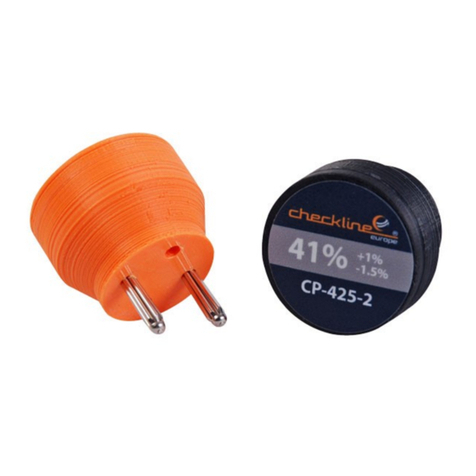
Check-line
Check-line CP-425-KIT User manual
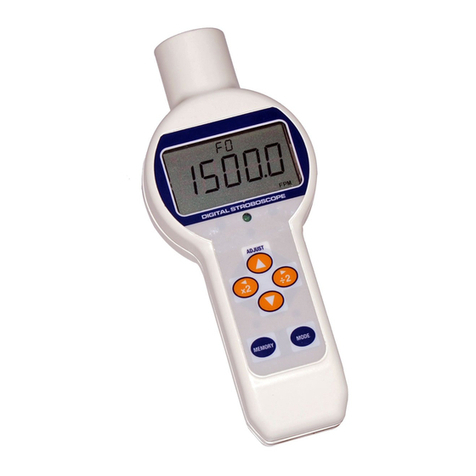
Check-line
Check-line NS-600 User manual
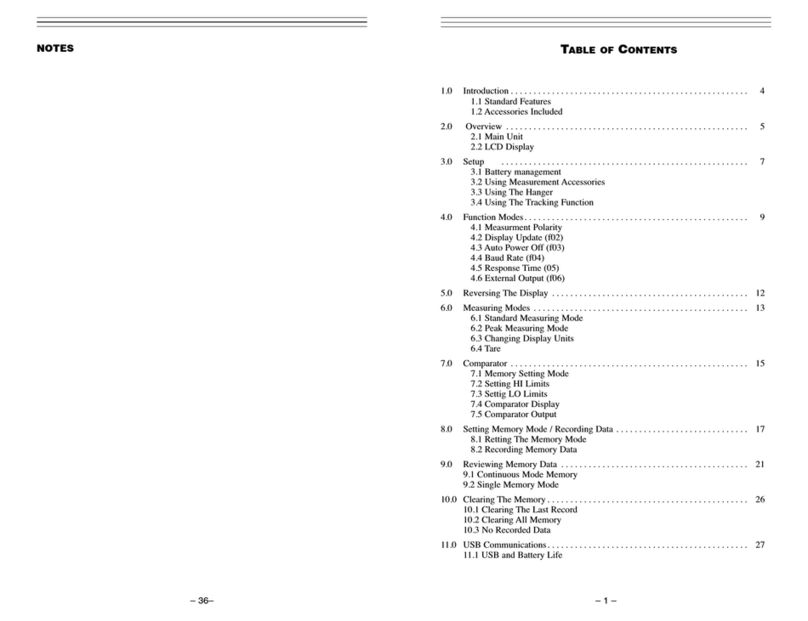
Check-line
Check-line FGV-XY User manual

Check-line
Check-line MiniTest 7200 FH Manual
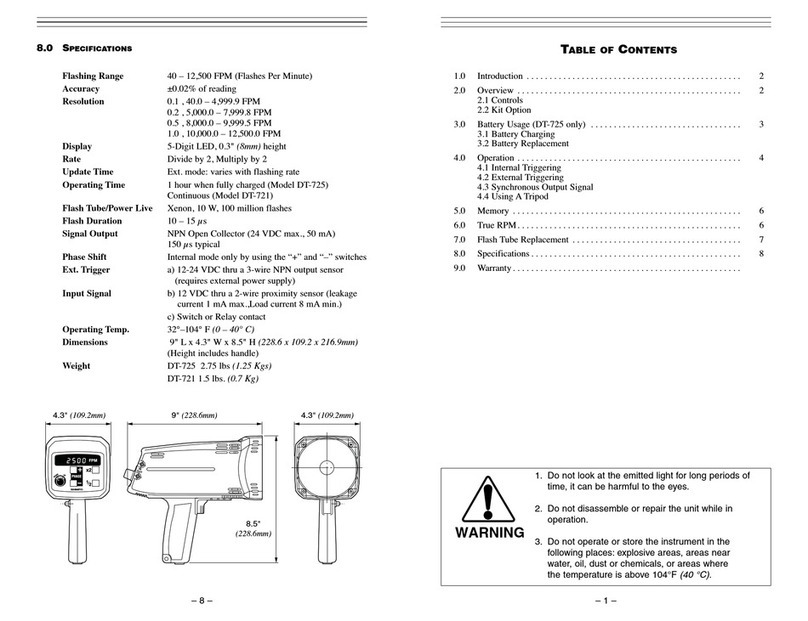
Check-line
Check-line DT-725 User manual
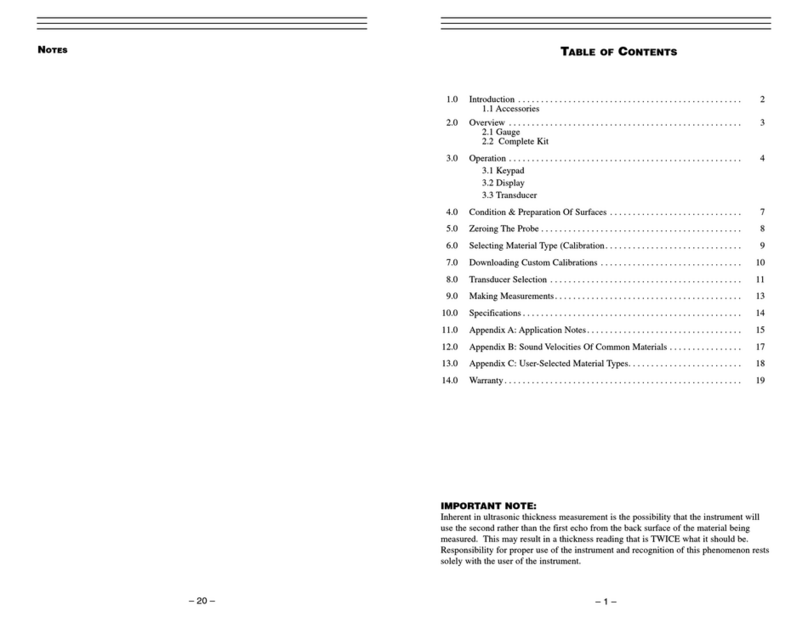
Check-line
Check-line TI-25S User manual
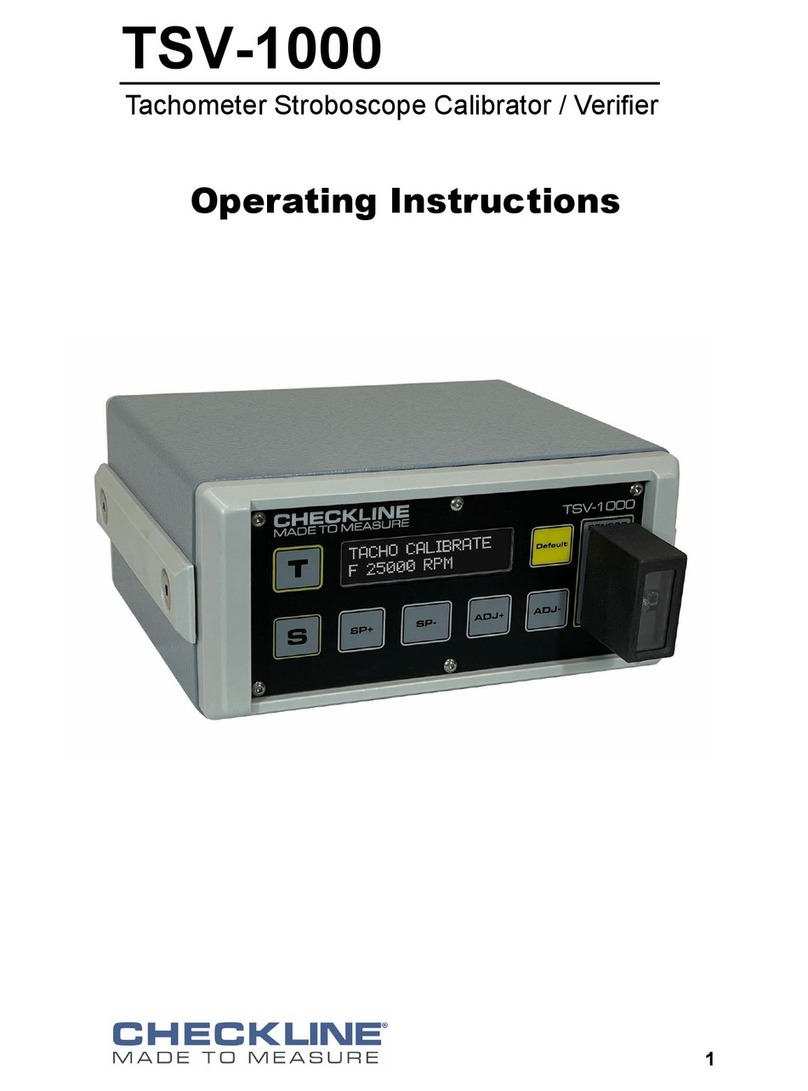
Check-line
Check-line TSV-1000 User manual


